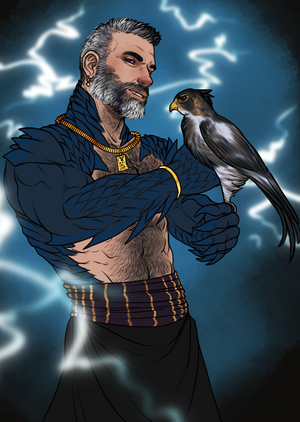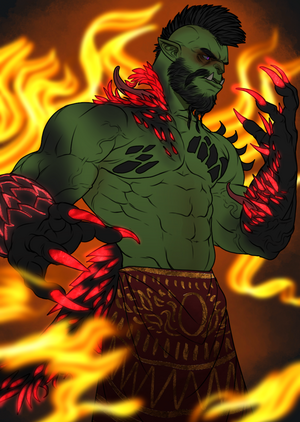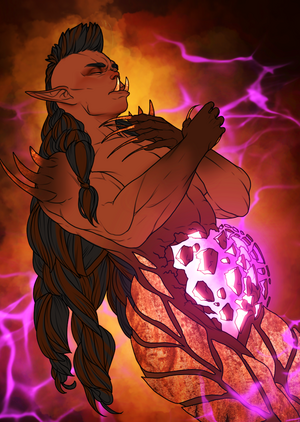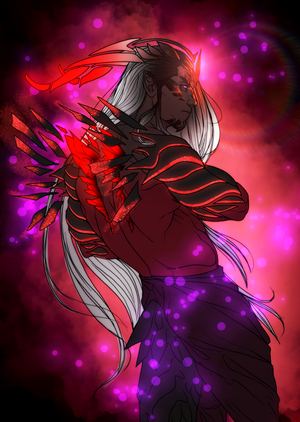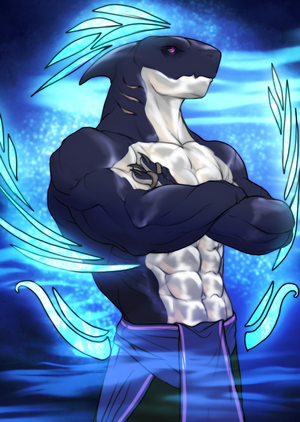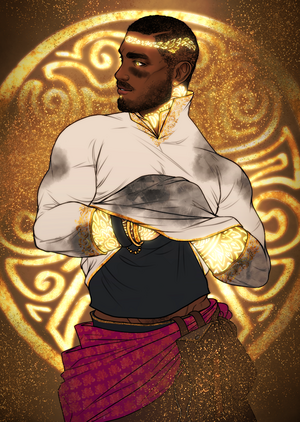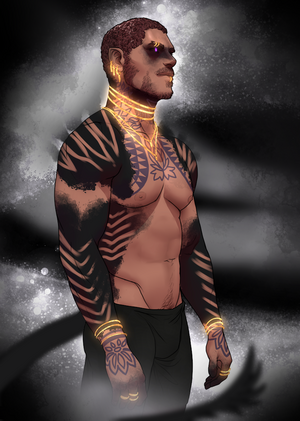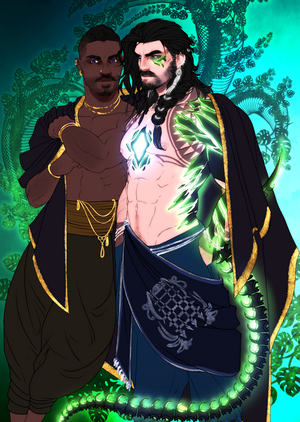Draconism: Difference between revisions
No edit summary |
No edit summary |
||
| (36 intermediate revisions by 5 users not shown) | |||
| Line 1: | Line 1: | ||
{{Info religion | |||
|image = Gdwsgdse.png | |||
|pronunciation = Dra-konism | |||
|origins = Unknown, presumed over 70.000 years ago | |||
|deities = Regulus, Caius, Daiana, Triton, Nox, Marik, Severena, Aurora. | |||
|subsects = N/A | |||
|}} | |||
==Origins== | ==Origins== | ||
== | ===Divine Mechanics=== | ||
All Religions provide 1 single Mechanic to their Believers that fits within the flair of their Religion. This Mechanic is lost if the individual stops believing in the Religion, or becomes a heretic, but can be regained. Afflicted can use this mechanic, but having the mechanic does not imply that they have blanket forgiveness from their Gods, just that there is more nuance to it than that. | |||
* Draconism worshipers are able to use Persuasion Dice rolls on Gods both outside and inside of [[Divinium]] summonings which is normally not possible. Additionally they gain +2 to every Dice roll of Persuasion against a God, and their Persuasion Cap is raised by +2 when rolling against Gods. | |||
==Gods and Goddesses== | ==Gods and Goddesses== | ||
===Regulus, the Blue King Dragon=== | |||
{| | |||
|- | |||
| rowspan="4" | [[File:Cedragoin.png|300px|caption|left]] | |||
| style="font-weight:bold; width:75px; vertical-align:top;" | Description | |||
| style="vertical-align:top;" | | |||
|- | |||
| style="font-weight:bold; width:75px; vertical-align:top;" | Virtues | |||
| style="vertical-align:top;" | | |||
|- | |||
| style="font-weight:bold; width:75px; vertical-align:top;" | Vices | |||
| style="vertical-align:top;" | | |||
|- | |||
| style="font-weight:bold; width:75px; vertical-align:top;" | Radical | |||
| style="vertical-align:top;" | | |||
|} | |||
===Caius, the Red Dying Dragon=== | |||
{| | {| | ||
[[File: | |- | ||
| | | rowspan="4" | [[File:Caiuodragon.png|300px|caption|left]] | ||
| style="font-weight:bold; width:75px; vertical-align:top;" | Description | |||
| style="vertical-align:top;" | | |||
|- | |||
| style="font-weight:bold; width:75px; vertical-align:top;" | Virtues | |||
| style="vertical-align:top;" | | |||
|- | |||
| style="font-weight:bold; width:75px; vertical-align:top;" | Vices | |||
| style="vertical-align:top;" | | |||
|- | |||
| style="font-weight:bold; width:75px; vertical-align:top;" | Radical | |||
| style="vertical-align:top;" | | |||
|} | |||
===Daiana, the Gray Dreaming Dragon=== | |||
{| | |||
|- | |||
| rowspan="4" | [[File:Dreamdragon.png|300px|caption|left]] | |||
| style="font-weight:bold; width:75px; vertical-align:top;" | Description | |||
| style="vertical-align:top;" | | |||
|- | |||
| style="font-weight:bold; width:75px; vertical-align:top;" | Virtues | |||
| style="vertical-align:top;" | | |||
|- | |||
| style="font-weight:bold; width:75px; vertical-align:top;" | Vices | |||
| style="vertical-align:top;" | | |||
|- | |||
| style="font-weight:bold; width:75px; vertical-align:top;" | Radical | |||
| style="vertical-align:top;" | | |||
|} | |||
===Triton, the Black Chain Dragon=== | |||
{| | |||
|- | |||
| rowspan="4" | [[File:Voiddragon.png|300px|caption|left]] | |||
| style="font-weight:bold; width:75px; vertical-align:top;" | Description | |||
| style="vertical-align:top;" | | |||
|- | |||
| style="font-weight:bold; width:75px; vertical-align:top;" | Virtues | |||
| style="vertical-align:top;" | | |||
|- | |||
| style="font-weight:bold; width:75px; vertical-align:top;" | Vices | |||
| style="vertical-align:top;" | | |||
|- | |||
| style="font-weight:bold; width:75px; vertical-align:top;" | Radical | |||
| style="vertical-align:top;" | | |||
|} | |||
===Nox, the Teal Unseen Dragon=== | |||
{| | |||
|- | |||
| rowspan="4" | [[File:Dueuaj.png|300px|caption|left]] | |||
| style="font-weight:bold; width:75px; vertical-align:top;" | Description | |||
| style="vertical-align:top;" | | |||
|- | |||
| style="font-weight:bold; width:75px; vertical-align:top;" | Virtues | |||
| style="vertical-align:top;" | | |||
|- | |||
| style="font-weight:bold; width:75px; vertical-align:top;" | Vices | |||
| style="vertical-align:top;" | | |||
|- | |||
| style="font-weight:bold; width:75px; vertical-align:top;" | Radical | |||
| style="vertical-align:top;" | | |||
|} | |||
===Marik, the Brown Etherforge Dragon=== | |||
{| | |||
|- | |||
| rowspan="4" | [[File:Yayh.png|300px|caption|left]] | |||
| style="font-weight:bold; width:75px; vertical-align:top;" | Description | |||
| style="vertical-align:top;" | | |||
|- | |||
| style="font-weight:bold; width:75px; vertical-align:top;" | Virtues | |||
| style="vertical-align:top;" | | |||
|- | |||
| style="font-weight:bold; width:75px; vertical-align:top;" | Vices | |||
| style="vertical-align:top;" | | |||
|- | |||
| style="font-weight:bold; width:75px; vertical-align:top;" | Radical | |||
| style="vertical-align:top;" | | |||
|} | |} | ||
===Umbra, the White Twilight Dragon=== | |||
{| | {| | ||
[[File: | |- | ||
| | | rowspan="4" | [[File:Monkeydragongod.png|300px|caption|left]] | ||
| style="font-weight:bold; width:75px; vertical-align:top;" | Description | |||
| style="vertical-align:top;" | | |||
|- | |||
| style="font-weight:bold; width:75px; vertical-align:top;" | Virtues | |||
| style="vertical-align:top;" | | |||
|- | |||
| style="font-weight:bold; width:75px; vertical-align:top;" | Vices | |||
| style="vertical-align:top;" | | |||
|- | |||
| style="font-weight:bold; width:75px; vertical-align:top;" | Radical | |||
| style="vertical-align:top;" | | |||
|} | |} | ||
===Felicula, the Yellow Harmony Dragon=== | |||
{| | {| | ||
[[File: | |- | ||
| | | rowspan="4" | [[File:Noimglong.png|300px|caption|left]] | ||
| style="font-weight:bold; width:75px; vertical-align:top;" | Description | |||
| style="vertical-align:top;" | | |||
|- | |||
| style="font-weight:bold; width:75px; vertical-align:top;" | Virtues | |||
| style="vertical-align:top;" | | |||
|- | |||
| style="font-weight:bold; width:75px; vertical-align:top;" | Vices | |||
| style="vertical-align:top;" | | |||
|- | |||
| style="font-weight:bold; width:75px; vertical-align:top;" | Radical | |||
| style="vertical-align:top;" | | |||
|} | |} | ||
===Severena, the Green Stalwart Dragon=== | |||
{| | {| | ||
[[File: | |- | ||
| | | rowspan="4" | [[File:Noimglong.png|300px|caption|left]] | ||
| style="font-weight:bold; width:75px; vertical-align:top;" | Description | |||
| style="vertical-align:top;" | | |||
|- | |||
| style="font-weight:bold; width:75px; vertical-align:top;" | Virtues | |||
| style="vertical-align:top;" | | |||
|- | |||
| style="font-weight:bold; width:75px; vertical-align:top;" | Vices | |||
| style="vertical-align:top;" | | |||
|- | |||
| style="font-weight:bold; width:75px; vertical-align:top;" | Radical | |||
| style="vertical-align:top;" | | |||
|} | |} | ||
===Aurora, the Purple Creation Dragon=== | |||
{| | {| | ||
[[File: | |- | ||
| | | rowspan="4" | [[File:Noimglong.png|300px|caption|left]] | ||
| style="font-weight:bold; width:75px; vertical-align:top;" | Description | |||
| style="vertical-align:top;" | | |||
|- | |||
| style="font-weight:bold; width:75px; vertical-align:top;" | Virtues | |||
| style="vertical-align:top;" | | |||
|- | |||
| style="font-weight:bold; width:75px; vertical-align:top;" | Vices | |||
| style="vertical-align:top;" | | |||
|- | |||
| style="font-weight:bold; width:75px; vertical-align:top;" | Radical | |||
| style="vertical-align:top;" | | |||
|} | |} | ||
===Gaia, the Indigo Nature Dragon=== | |||
{| | {| | ||
[[File: | |- | ||
| | | rowspan="4" | [[File:New Canvadddsrtetgr.png|300px|caption|left]] | ||
| style="font-weight:bold; width:75px; vertical-align:top;" | Description | |||
| style="vertical-align:top;" | | |||
Gaia is not a Dragon exactly, but a mortal Aelrrigan Knight named Iorwerth (depicted right) who was an Archon serving the Dragons, carrying the soul of the dead Dragon Gaia. For centuries, Iorwerth was forced to serve the Malefica, one of the greatest unseen enemies of the Dragons, forced to conjure up vast magical structures, mazes, and fortresses for the Malefica and its Shades to use to deal death on mortals in the living world. He was forced to do this because his lover Cadell's (depicted left) soul had been captured by the Malefica, who used him as a bargain to string Iorwerth along. Through the intervention of mortals in Regalia, Iorwerth and Cadell were able to break free from the Malefica's control, and return to Aloria. There he rekindled with the Dragons he once served, but also still held the power of Ordial god-hood. For this, the Dragons tasked him to ascend to their pantheon by being the (somewhat reluctant) host of Gaia's Dragon Soulspark, a Dragon who had perished many centuries ago during the Denial of Immortality. While many of Iorwerth's structures still serve the Malefica, all have become overgrown with lush vines and the Lillies of the Valley, Iorwerth and Cadell's favorite flower. In this, Gaia's powers manifest as the Dragon of Nature, the other half of Aurora's Craters of Creation. While she created the living beings that inhabited nature, it was Gaia who created the plants and trees and flowers that decorate all the realms. Thus, carrying life and death in his body and his love by his side, Iorwerth is the Draconic God of Nature, tranquility, absolution, and redemption in rebirth. | |||
|- | |||
| style="font-weight:bold; width:75px; vertical-align:top;" | Virtues | |||
| style="vertical-align:top;" | | |||
Virtue to Gaia (This God is both called Gaia and Iorwerth) is preserving balance of nature, in the give and take between the forces within an ecosystem, and preventing cascade collapse due to dying flora. From the smallest of maggots, to the largest of mammals, nature exists as the bedrock of life on Aloria. Iorwerth specifically adds to this, by making the act of redemption both in receiving and offering others the chance, a true virtue and to never give up in the face of even the most malicious of death-bound forces to return to a righted world and make amends. | |||
|- | |||
| style="font-weight:bold; width:75px; vertical-align:top;" | Vices | |||
| style="vertical-align:top;" | | |||
Vices to Gaia, are the stupidity and naivety to outsmart forces greater in power than the self. In this, Iorwerth and Cadell's centuries-long imprisonment in the Beyond acts as a deterrent and a warning that evil forces are not interested in playing fair or honest, and that respecting duels or challenges of powerful entities is foolish. Iorwerth and Cadell express above all that it is a Vice to not seek help, to not ask for saving, and to foolhardy insist that the individual can overcome all trials and struggles alone. Gaia looks down on lone wolves who risk others with their own recklessness. | |||
|- | |||
| style="font-weight:bold; width:75px; vertical-align:top;" | Radical | |||
| style="vertical-align:top;" | | |||
Gaia's Radical is the Radical of Integration. This Radical proposes that the Occult can have the right to exist in the mortal world, but only insofar they are able to exist in a social ego system that is in harmony with their environment and the people around them. This vague concept proclaims that the Occult have a right to exist, but that to claim this right they must adapt and conform, concede, and compromise, and cannot hold onto selfish notions of complete autonomy. Failing this, Gaia's Radical proposes purging invasive Occult who disrupt social eco systems to preserve stability. | |||
|} | |} | ||
==Priesthood== | |||
==Morality of the Faith== | |||
===Celestial Festivals=== | |||
Draconist festivals are drawn up according to the twelve months of the year, placed exactly in the middle. These festivals are open to the non-faithful as well, in the search to entice new converts. The twelve monthly festivals are: | |||
* '''Wildcard Festival (January 15)''': Taking place at the heart of winter, this celebration is an invitation for the priests of the community to celebrate the important events of the previous year in broader retrospective of all that has come to pass. This Festival specifically also celebrates Regulus and the Blue Dragons. | |||
* '''Before-Spring (February 15)''': Amidst the clearing of the frost, this Draconist festival sees the creation of garland, bouquets, and other arrangements to show respect for nature. Nature-walks, protests of industrialization, and celebrations of the natural world via communal learning are commonly held during this time. This Festival specifically also celebrates Aurora and the Purple Dragons. | |||
* '''Storyteller’s Festival (March 15)''': This festival is a celebration of the power of stories, and their importance in preserving oral history, especially when so much knowledge of the Dragons has been lost. Worshippers usually gather in someone’s home, or around a large stage, and take turns telling their favorite story. The tales are usually non-fiction, but fictional stories are allowed and encouraged, as long as they have some moral lesson or point. | |||
* ''' All-Faith Tournament (April 15)''': This festival features ritualistic fighting between groups (or pairs) of warriors in the name of the Dragons. It is common for Draconists to invite fighters from other faiths, and include them in the battle, primarily to show the grace of the Dragons, but also to show off the martial prowess of the Archon and Draconists who participate. Ritualistic Dragon-Magic is used to prevent anyone from outright dying in the arena, and this Festival (unofficially) celebrates Triton and his might. | |||
* '''Cycles of Creation (May 15)''': This festival is the Draconist version of a “Love Festival” common in many other cultures and religions. During the day, Draconists gather and encourage others to spend time with their loved ones, specifically handing out flower-wreathes to single individuals, encouraging others to talk to them. While the day celebrates platonic and romantic love, by the evening Draconists are encouraged to spend time with their romantic partner(s), and the festival is seen as a particularly holy and important time to procreate and make love, as a celebration of life. This Festival historically used to celebrate Caius and the Red Dragons, but doesn’t anymore. | |||
* '''Introspection Trials (June 15)''': This festival is less of a festival and more of a series of quests that Draconists task one another with, based on their perceived failures and weaknesses. Draconists are encouraged to devise a “mission” for another Draconist to try and complete, specifically with the intent of helping them get over something they struggle with, or learn something new, or improve and better themselves in some way. Succeeding in this task obligates the Draconist who did the quest to treat the quest-giver in some way (dinner, drink, a gift, etc), and the opposite if the Draconist fails (as consolation, the quest-giver treats them to something nice). Outright refusal to partake is looked down upon, and obligates all other Draconists to devise an even more convoluted quest. This Festival specifically also celebrates Severena and the Green Dragons. | |||
* '''Harmony Jubilee (July 15)''': This the largest and most bombastic of all of the Draconist Festivals, an all-day celebration including a large feast, dances, and loud music and song. Most importantly, the Jubilee has hospitality extended to enemies of the faithful during this time, meaning they will not be attacked or chased out, so long as they do not harm someone first, or callously insult the Draconists hosting the festival. It is for this reason that the Jubilee (in Regalia, at least) is usually held in the countryside, to prevent any arrests being made. This Festival specifically also celebrates Felicula and the Yellow Dragons. | |||
* '''Festival of Service (August 15)''': This festival has no defined structure, but is a celebration that encourages the faithful to remain humble, and offer their aid to others. For the entire day, Draconists travel in groups and offer their help, free of charge or expectation of repayment, to anyone who might need it. This can range from helping someone clean up their store, to building a home, to offering relationship advice, or trying to track down a lost pet, as long as the request does not obligate the Draconists to do something violent or offensive to their morals. This Festival specifically also celebrates Marik and the Brown Dragons. | |||
* '''Mourning Festival (September 15)''': It is common for this festival to feature processions in the streets of towns and cities where Draconists carry candles to graveyards of other religions, to offer their condolences to remember the dead and honor their memory, no matter their religion or culture or citizenship. This Festival specifically also celebrates Umbra and the White Dragons. | |||
* '''Harvest Ritual (October 15)''': This festival celebrates the harvest via a large potluck, where everyone contributes some ingredient or dish. The feast is a large public gathering, where non-Draconists are welcome to bring their own food and dishes. It also features lots of colors, as it is common to have dyed chalk that is smeared across people’s skin and clothes to mark them as worshippers of a particular Dragon. This Festival specifically also celebrates Daiana and the Gray Dragons. | |||
* '''The Eternal Vigil (November 15)''': This festival is a solemn vigil in remembrance of the Archon who gave their lives historically, and even now, to protect and champion the cause of the Dragons. It is a festival that reflects on the suffering of the Archon, and even of the Dragons, at the hands of demonic forces. This Festival specifically also celebrates (or mourns) Caius and the Red Dragons. | |||
* '''Gift-Giving and Sharing Ceremony (December 15)''': On this day, Draconists traditionally give each other personalized and thoughtful gifts of little monetary value. Usually, Draconists will choose a small number of people who they felt helped them the most throughout the year, and offer them gifts, with the expectation that everyone should get something. During this time, Draconists also partake in the ritual of sharing and absolution, wherein Draconists can reveal secrets or things they have kept hidden, that they regret or feel shame about, with the promise that by sharing at this ceremony, they will not be completely shunned or abandoned. To reveal a secret at this festival is a sacred act, and while it will not absolve them of all possible sins, it does ensure that the other Draconists will work to help them through it, and repent (if needed). This Festival specifically used to celebrate Nox, but, after his sin and banishment, it no longer does (publicly, anyways). Nox worshippers and Slizzar still hold this festival as a celebration of him and his wisdom. | |||
===Rising=== | |||
The act of Rising is one of the more complicated rituals a Draconist priest can perform, and is a harmless event performed in the name of Daiana meant to give closure to a member of the living through the calling forth the target of their communion. It should be stated clearly that this ritual is not a Summoning or Evoking, and the entity that appears is only a visual construct from the memories of the participating party. This form can be the appearance of dead relatives, close friends, or those who were sadly taken too soon from a partner that they loved. The act of Rising is meant to provide closure, and priests as channelers of the ritual and also emotional guides, speak through their “puppet,” being granted temporary access to relevant memories shared between these two figures, or which might be useful in providing the living subject closure. Rising is seen as sacred among Draconists, while also being something that a priest does not perform lightly. An individual usually has to have a real emotional block in their mindset regarding a lost loved one for a priest to consider a Rising. | |||
==Trivia== | ==Trivia== | ||
To be Expanded. | |||
{{Religion}} | |||
{{Accreditation | |||
|Artists = | |||
|Writers = MonMarty | |||
|Processors = FireFan96 | |||
}} | |||
[[category:Religion]] | |||
Revision as of 07:03, 30 April 2024
| Draconism | |
|---|---|
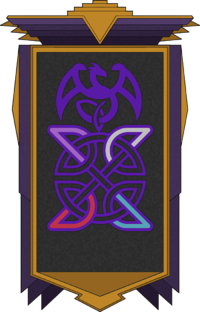 | |
| Religion | |
| Pronunciation | Dra-konism |
| Origins | Unknown, presumed over 70.000 years ago |
| Deities | |
| Regulus, Caius, Daiana, Triton, Nox, Marik, Severena, Aurora. | |
| Subsects | |
| N/A | |
Origins
Divine Mechanics
All Religions provide 1 single Mechanic to their Believers that fits within the flair of their Religion. This Mechanic is lost if the individual stops believing in the Religion, or becomes a heretic, but can be regained. Afflicted can use this mechanic, but having the mechanic does not imply that they have blanket forgiveness from their Gods, just that there is more nuance to it than that.
- Draconism worshipers are able to use Persuasion Dice rolls on Gods both outside and inside of Divinium summonings which is normally not possible. Additionally they gain +2 to every Dice roll of Persuasion against a God, and their Persuasion Cap is raised by +2 when rolling against Gods.
Gods and Goddesses
Regulus, the Blue King Dragon
| Description | ||
| Virtues | ||
| Vices | ||
| Radical |
Caius, the Red Dying Dragon
| Description | ||
| Virtues | ||
| Vices | ||
| Radical |
Daiana, the Gray Dreaming Dragon
| Description | ||
| Virtues | ||
| Vices | ||
| Radical |
Triton, the Black Chain Dragon
| Description | ||
| Virtues | ||
| Vices | ||
| Radical |
Nox, the Teal Unseen Dragon
| Description | ||
| Virtues | ||
| Vices | ||
| Radical |
Marik, the Brown Etherforge Dragon
| Description | ||
| Virtues | ||
| Vices | ||
| Radical |
Umbra, the White Twilight Dragon
| Description | ||
| Virtues | ||
| Vices | ||
| Radical |
Felicula, the Yellow Harmony Dragon
| Description | ||
| Virtues | ||
| Vices | ||
| Radical |
Severena, the Green Stalwart Dragon
| Description | ||
| Virtues | ||
| Vices | ||
| Radical |
Aurora, the Purple Creation Dragon
| Description | ||
| Virtues | ||
| Vices | ||
| Radical |
Gaia, the Indigo Nature Dragon
| Description |
Gaia is not a Dragon exactly, but a mortal Aelrrigan Knight named Iorwerth (depicted right) who was an Archon serving the Dragons, carrying the soul of the dead Dragon Gaia. For centuries, Iorwerth was forced to serve the Malefica, one of the greatest unseen enemies of the Dragons, forced to conjure up vast magical structures, mazes, and fortresses for the Malefica and its Shades to use to deal death on mortals in the living world. He was forced to do this because his lover Cadell's (depicted left) soul had been captured by the Malefica, who used him as a bargain to string Iorwerth along. Through the intervention of mortals in Regalia, Iorwerth and Cadell were able to break free from the Malefica's control, and return to Aloria. There he rekindled with the Dragons he once served, but also still held the power of Ordial god-hood. For this, the Dragons tasked him to ascend to their pantheon by being the (somewhat reluctant) host of Gaia's Dragon Soulspark, a Dragon who had perished many centuries ago during the Denial of Immortality. While many of Iorwerth's structures still serve the Malefica, all have become overgrown with lush vines and the Lillies of the Valley, Iorwerth and Cadell's favorite flower. In this, Gaia's powers manifest as the Dragon of Nature, the other half of Aurora's Craters of Creation. While she created the living beings that inhabited nature, it was Gaia who created the plants and trees and flowers that decorate all the realms. Thus, carrying life and death in his body and his love by his side, Iorwerth is the Draconic God of Nature, tranquility, absolution, and redemption in rebirth. | |
| Virtues |
Virtue to Gaia (This God is both called Gaia and Iorwerth) is preserving balance of nature, in the give and take between the forces within an ecosystem, and preventing cascade collapse due to dying flora. From the smallest of maggots, to the largest of mammals, nature exists as the bedrock of life on Aloria. Iorwerth specifically adds to this, by making the act of redemption both in receiving and offering others the chance, a true virtue and to never give up in the face of even the most malicious of death-bound forces to return to a righted world and make amends. | |
| Vices |
Vices to Gaia, are the stupidity and naivety to outsmart forces greater in power than the self. In this, Iorwerth and Cadell's centuries-long imprisonment in the Beyond acts as a deterrent and a warning that evil forces are not interested in playing fair or honest, and that respecting duels or challenges of powerful entities is foolish. Iorwerth and Cadell express above all that it is a Vice to not seek help, to not ask for saving, and to foolhardy insist that the individual can overcome all trials and struggles alone. Gaia looks down on lone wolves who risk others with their own recklessness. | |
| Radical |
Gaia's Radical is the Radical of Integration. This Radical proposes that the Occult can have the right to exist in the mortal world, but only insofar they are able to exist in a social ego system that is in harmony with their environment and the people around them. This vague concept proclaims that the Occult have a right to exist, but that to claim this right they must adapt and conform, concede, and compromise, and cannot hold onto selfish notions of complete autonomy. Failing this, Gaia's Radical proposes purging invasive Occult who disrupt social eco systems to preserve stability. |
Priesthood
Morality of the Faith
Celestial Festivals
Draconist festivals are drawn up according to the twelve months of the year, placed exactly in the middle. These festivals are open to the non-faithful as well, in the search to entice new converts. The twelve monthly festivals are:
- Wildcard Festival (January 15): Taking place at the heart of winter, this celebration is an invitation for the priests of the community to celebrate the important events of the previous year in broader retrospective of all that has come to pass. This Festival specifically also celebrates Regulus and the Blue Dragons.
- Before-Spring (February 15): Amidst the clearing of the frost, this Draconist festival sees the creation of garland, bouquets, and other arrangements to show respect for nature. Nature-walks, protests of industrialization, and celebrations of the natural world via communal learning are commonly held during this time. This Festival specifically also celebrates Aurora and the Purple Dragons.
- Storyteller’s Festival (March 15): This festival is a celebration of the power of stories, and their importance in preserving oral history, especially when so much knowledge of the Dragons has been lost. Worshippers usually gather in someone’s home, or around a large stage, and take turns telling their favorite story. The tales are usually non-fiction, but fictional stories are allowed and encouraged, as long as they have some moral lesson or point.
- All-Faith Tournament (April 15): This festival features ritualistic fighting between groups (or pairs) of warriors in the name of the Dragons. It is common for Draconists to invite fighters from other faiths, and include them in the battle, primarily to show the grace of the Dragons, but also to show off the martial prowess of the Archon and Draconists who participate. Ritualistic Dragon-Magic is used to prevent anyone from outright dying in the arena, and this Festival (unofficially) celebrates Triton and his might.
- Cycles of Creation (May 15): This festival is the Draconist version of a “Love Festival” common in many other cultures and religions. During the day, Draconists gather and encourage others to spend time with their loved ones, specifically handing out flower-wreathes to single individuals, encouraging others to talk to them. While the day celebrates platonic and romantic love, by the evening Draconists are encouraged to spend time with their romantic partner(s), and the festival is seen as a particularly holy and important time to procreate and make love, as a celebration of life. This Festival historically used to celebrate Caius and the Red Dragons, but doesn’t anymore.
- Introspection Trials (June 15): This festival is less of a festival and more of a series of quests that Draconists task one another with, based on their perceived failures and weaknesses. Draconists are encouraged to devise a “mission” for another Draconist to try and complete, specifically with the intent of helping them get over something they struggle with, or learn something new, or improve and better themselves in some way. Succeeding in this task obligates the Draconist who did the quest to treat the quest-giver in some way (dinner, drink, a gift, etc), and the opposite if the Draconist fails (as consolation, the quest-giver treats them to something nice). Outright refusal to partake is looked down upon, and obligates all other Draconists to devise an even more convoluted quest. This Festival specifically also celebrates Severena and the Green Dragons.
- Harmony Jubilee (July 15): This the largest and most bombastic of all of the Draconist Festivals, an all-day celebration including a large feast, dances, and loud music and song. Most importantly, the Jubilee has hospitality extended to enemies of the faithful during this time, meaning they will not be attacked or chased out, so long as they do not harm someone first, or callously insult the Draconists hosting the festival. It is for this reason that the Jubilee (in Regalia, at least) is usually held in the countryside, to prevent any arrests being made. This Festival specifically also celebrates Felicula and the Yellow Dragons.
- Festival of Service (August 15): This festival has no defined structure, but is a celebration that encourages the faithful to remain humble, and offer their aid to others. For the entire day, Draconists travel in groups and offer their help, free of charge or expectation of repayment, to anyone who might need it. This can range from helping someone clean up their store, to building a home, to offering relationship advice, or trying to track down a lost pet, as long as the request does not obligate the Draconists to do something violent or offensive to their morals. This Festival specifically also celebrates Marik and the Brown Dragons.
- Mourning Festival (September 15): It is common for this festival to feature processions in the streets of towns and cities where Draconists carry candles to graveyards of other religions, to offer their condolences to remember the dead and honor their memory, no matter their religion or culture or citizenship. This Festival specifically also celebrates Umbra and the White Dragons.
- Harvest Ritual (October 15): This festival celebrates the harvest via a large potluck, where everyone contributes some ingredient or dish. The feast is a large public gathering, where non-Draconists are welcome to bring their own food and dishes. It also features lots of colors, as it is common to have dyed chalk that is smeared across people’s skin and clothes to mark them as worshippers of a particular Dragon. This Festival specifically also celebrates Daiana and the Gray Dragons.
- The Eternal Vigil (November 15): This festival is a solemn vigil in remembrance of the Archon who gave their lives historically, and even now, to protect and champion the cause of the Dragons. It is a festival that reflects on the suffering of the Archon, and even of the Dragons, at the hands of demonic forces. This Festival specifically also celebrates (or mourns) Caius and the Red Dragons.
- Gift-Giving and Sharing Ceremony (December 15): On this day, Draconists traditionally give each other personalized and thoughtful gifts of little monetary value. Usually, Draconists will choose a small number of people who they felt helped them the most throughout the year, and offer them gifts, with the expectation that everyone should get something. During this time, Draconists also partake in the ritual of sharing and absolution, wherein Draconists can reveal secrets or things they have kept hidden, that they regret or feel shame about, with the promise that by sharing at this ceremony, they will not be completely shunned or abandoned. To reveal a secret at this festival is a sacred act, and while it will not absolve them of all possible sins, it does ensure that the other Draconists will work to help them through it, and repent (if needed). This Festival specifically used to celebrate Nox, but, after his sin and banishment, it no longer does (publicly, anyways). Nox worshippers and Slizzar still hold this festival as a celebration of him and his wisdom.
Rising
The act of Rising is one of the more complicated rituals a Draconist priest can perform, and is a harmless event performed in the name of Daiana meant to give closure to a member of the living through the calling forth the target of their communion. It should be stated clearly that this ritual is not a Summoning or Evoking, and the entity that appears is only a visual construct from the memories of the participating party. This form can be the appearance of dead relatives, close friends, or those who were sadly taken too soon from a partner that they loved. The act of Rising is meant to provide closure, and priests as channelers of the ritual and also emotional guides, speak through their “puppet,” being granted temporary access to relevant memories shared between these two figures, or which might be useful in providing the living subject closure. Rising is seen as sacred among Draconists, while also being something that a priest does not perform lightly. An individual usually has to have a real emotional block in their mindset regarding a lost loved one for a priest to consider a Rising.
Trivia
To be Expanded.
| ||||||||||
| Accreditation | |||||||
|---|---|---|---|---|---|---|---|
|
| ||||||
